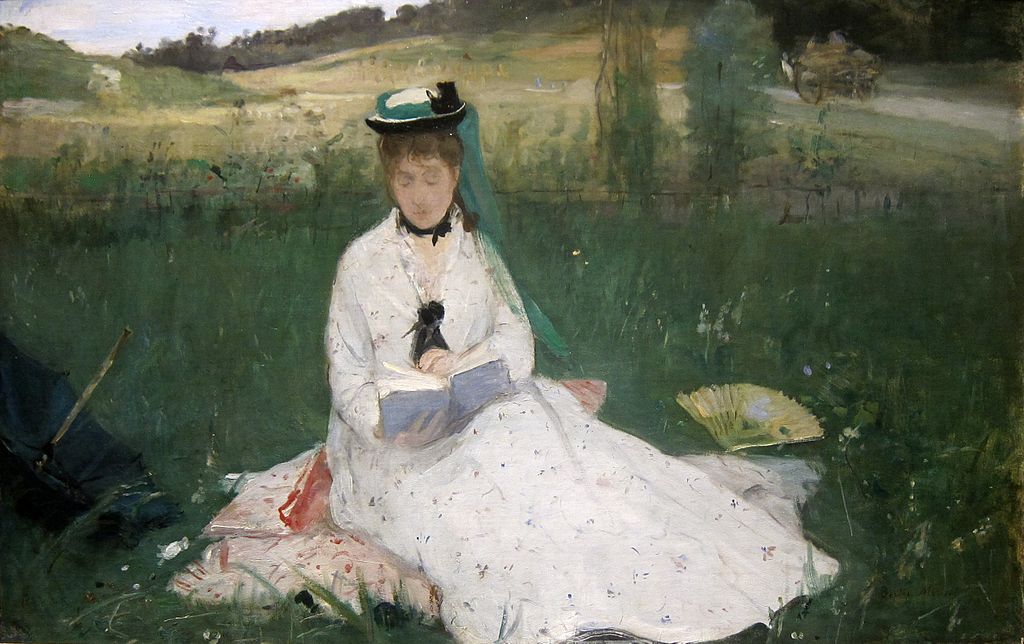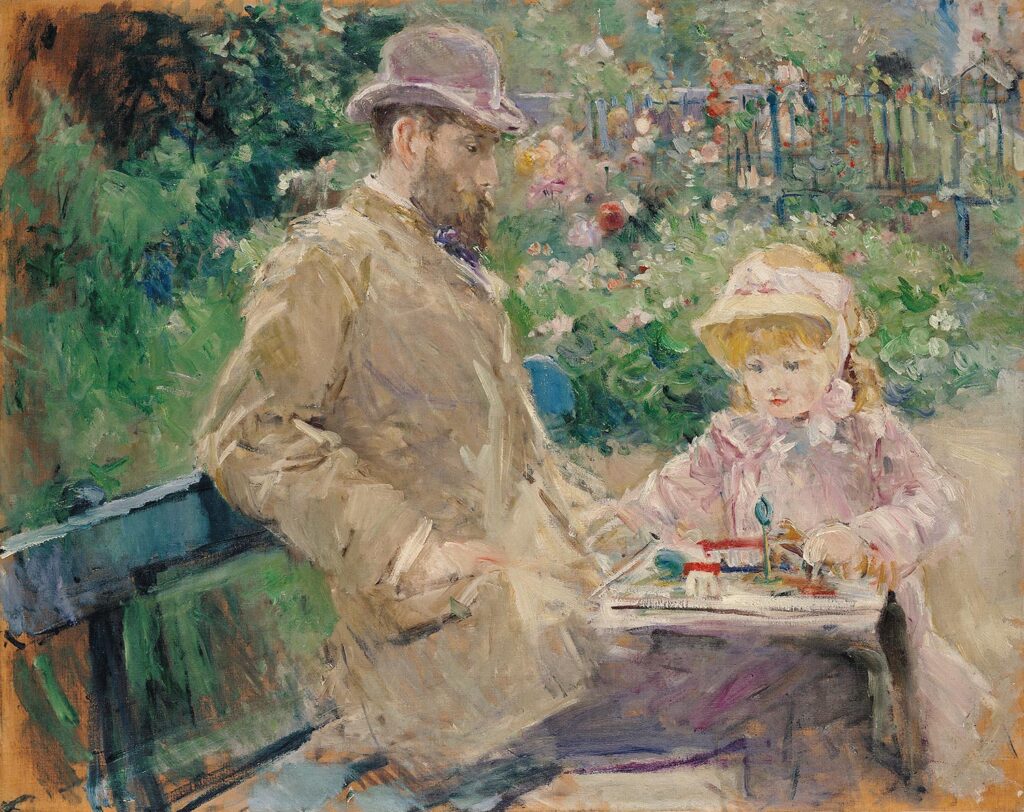Masterpiece Story: L.O.V.E. by Maurizio Cattelan
In the heart of Milan, steps away from the iconic Duomo, Piazza Affari hosts a provocative sculpture by Maurizio Cattelan. Titled...
Lisa Scalone 8 July 2024
Berthe Morisot was at the centre of Impressionism during the 1870s and 1880s and works like Summer’s Day seem utterly characteristic of the movement. However, Morisot had her own distinctive style and, as a female artist, faced her own unique problems.

Édouard Manet, Berthe Morisot with a Bouquet of Violets, 1872, Musée d’Orsay, Paris, France.
Berthe Morisot (1841-1895) participated in all but one of the Impressionist exhibitions and Summer’s Day was one of a number of works she showed in 1880. Morisot socialized with Camille Pissarro and Edgar Degas, and Édouard Manet was a lifelong friend and admirer. She features as a model in some of his works, like The Balcony (1868-9) and he painted her portrait several times. Manet, although often linked to the Impressionists, never exhibited with them. In some ways, it is perhaps surprising that Morisot, who had successfully shown at the official Salon from 1864, did not follow his lead.
Instead, she became actively involved in the Impressionist exhibitions, starting with the first show in 1874, where she exhibited five oils (including The Cradle), watercolors, and pastels. Her works went on to sell for as much as those of her male counterparts. Morisot also played a significant organizational role in the movement.

Berthe Morisot, Reading (Portrait of Edma Morisot), 1873, Cleveland Museum of Art, Cleveland, OH, USA.
Together with her sister, Morisot had received basic art lessons, like many middle-class young women, but unlike most, she was determined to become an artist. Her first teacher described the idea as ‘revolutionary, I might say almost catastrophic’ but she was not to be dissuaded. She took further studies, including with landscapist Camille Corot, one of the mid-19th century painters who had pioneered painting outside and popularized landscape art in France. His softly focused, cool-colored scenes were to be a major influence on her art.

Berthe Morisot, Eugène Manet and His Daughter Julie in the Garden at Bougival, 1881, Musée Marmottan Monet, Paris, France.
Morisot’s sister had been a keen and talented artist who gave up painting when she got married, as many women of the period chose to do. Morisot was determined not to take the same route. She delayed marriage until she found a sympathetic husband in the form of Manet’s brother, Eugène, whom she married in 1874. Eugène, an amateur artist himself, supported his wife’s ambition – he even posed for paintings.
Morisot’s only child, Julie, was born in November 1878, and she too became the subject of many paintings. The birth did, however, impact Morisot’s art. She did not exhibit at the Impressionist exhibition the following spring, and she started to produce more watercolors which were easier and quicker to work on.
As a wealthy mother, Morisot was well-supported by a wet nurse (who breastfed the baby) and a nanny as well as other household servants. This gave her the freedom to continue painting, although she based much of her practice around her house and garden. She regularly painted in the drawing room rather than a designated studio so that she always felt present.
Summer’s Day was painted in the summer of 1879, in the Bois de Boulogne, Morisot’s local park, where she frequently walked with Julie, accompanied by a servant.

Berthe Morisot, In the Bois de Boulogne, c. 1879, Nationalmuseum, Stockholm, Sweden.
Artists had always sketched outdoors but what made the Impressionists different was their desire to produce finished canvases painted plein air (in the open). Morisot often worked outside in private spaces like her own garden, but it was much more difficult for a woman to paint undisturbed in a public place. She produced a watercolor sketch of Summer’s Day, now lost, in the Bois de Boulogne, but the painting that exists today, despite its spontaneous appearance, was painted at her home.
Morisot used professional models to pose in the park for two paintings: Summer’s Day and In the Bois de Boulogne – in both pictures, the women wear the same outfits. They would have gone early to avoid too much attention and posed briefly for sketches to be made. Most likely Morisot would have re-posed the women again in the studio or in her garden to achieve the finished paintings.

Édouard Manet, Boating, 1874, Metropolitan Museum of Art, New York City, NY, USA.
Scenes of rowers and boating were popular amongst the Impressionists: Pierre-Auguste Renoir and Gustave Caillebotte as well as Manet produced pictures of figures in boats and Claude Monet had his own floating studio which allowed him to paint all kinds of river views. Partly this reflected the popularity of boating as a leisure activity for Parisians, partly it allowed the Impressionists to explore the outdoor compositions that interested them. In Morisot’s case it gave her privacy and security, working in a boat meant she was less disturbed by curious onlookers.
Morisot, like Manet in Boating (1874), puts the viewer in the boat, making them part of the action. In both cases one figure looks out towards us, creating a connection, whilst the other seems oblivious of our presence. The lack of communication between the figures, together with Morisot’s sketchy treatment of their faces, creates an ambiguity. We have no idea of who these two women are, or their relationship to each other of the artist. This adds to the sense of immediacy, a captured moment, rather than a narrative.
Despite being very different in coloration and technique, both artists create an intimate focus on the boat and the water around, with little sense of recession and no sky. Manet’s blue water is like a wall behind the figures. Morisot has more background detail – the trees on the far back and the swans splashing beside the boat, but her repeated use of color and visible brushwork emphasize the canvas surface, especially through the strong brown diagonal of the side of the boat. This lack of recession and cut-off details were characteristic of Impressionism’s apparently ‘uncomposed’ compositions.

Berthe Morisot, Summer’s Day, c. 1879, National Gallery, London, UK.
Morisot’s brushwork is sketchy even by Impressionist standards. Whereas Monet and Renoir worked with essentially regular, small dabbed, and dashed brushstrokes, Morisot’s paint application is more varied and much broader. She often used zig-zag strokes which creates a real dynamism in her work. Areas of canvas, especially around the edges are barely covered at all. There is a breadth of handling – big, sweepingly applied strokes – which is more like Frans Hals and Diego Velázquez, and indeed Manet, who admired both.
Impressionist works were generally criticized by contemporaries as unfinished – ‘impressions’ of paintings rather than a complete images. However, in Morisot’s case, they considered that she ‘carries the system to an extreme’ and her works seem loose and sketchy even by modern standards. She described the painting as ‘being in a pitched battle’, working everything out on the canvas and fighting through mistakes with scrapings and over-painting. There is always a sense of that energy in her brushwork, often at odds with the calm subject matter and the pale, almost decorative colors.

Berthe Morisot, Summer’s Day, c. 1879, National Gallery, London, UK. Detail.
Contemporary critics often compared Morisot’s work to that of 18th-century Rococo artists. In part, this was a shorthand way of disparaging her as a woman, because Rococo art was seen as feminine, but Morisot herself admired the work of François Boucher and her palette is often dominated by the whites and pastels which can be found in his work. It was also, however, a color range that derived from her teacher, Corot.
Summer’s Day is very typical of her preference for a small range of blues, greens, and whites which immediately gives the painting a tonal harmony. Impressionism is often associated with strong color and the use of zingy complementaries, like blue and orange, whereas the most striking variation in Morisot’s work is the yellow straw of the women’s hats. Repeated areas of similar color, for instance, the darker blue of the jacket, the hat bow, and the background shadows dissolve distance and unify the picture surface. White highlights in unexpected areas, especially the swans, confuse the viewer into looking at the whole rather than the apparent subject of the women.

Berthe Morisot, Child Among the Hollyhocks, 1881, Wallraf-Richartz Museum, Cologne, Germany.
Berthe Morisot is often discussed primarily as a ‘female Impressionist’, and her subject matter is analyzed for its focus on women’s issues and domesticity. The reality is that her artistic choices were determined by convenience, and her technique was distinctly unfeminine with its emphasis on spiky zig-zags and cool colors. A painting like Summer’s Day arguably positions her as the most stylistically radical of all the Impressionists.
DailyArt Magazine needs your support. Every contribution, however big or small, is very valuable for our future. Thanks to it, we will be able to sustain and grow the Magazine. Thank you for your help!